by Abigail Anongos | Apr 7, 2021
Rachel Mariano and Betty Belen, indigenous women and human rights advocates share their incarceration stories due to trumped-up charges and evidence. The cause of their persecution is clear: they defend their ancestral lands. Because of their activities, their families and communities also suffer the impacts of prison. At present, both leaders have currently been released and continue to fight against the development projects of transnational companies in a context of escalating attacks against the indigenous peoples of the country.
Rachel Mariano is a member of the indigenous Ibaloi-Kankanaey people from the Benguet province. She is a community health worker who actively campaigns for people’s right to health. This people fiercely opposed large-scale open pit operations for many years, until the operations were halted. At present, their land remains threatened by other mining permit applications.
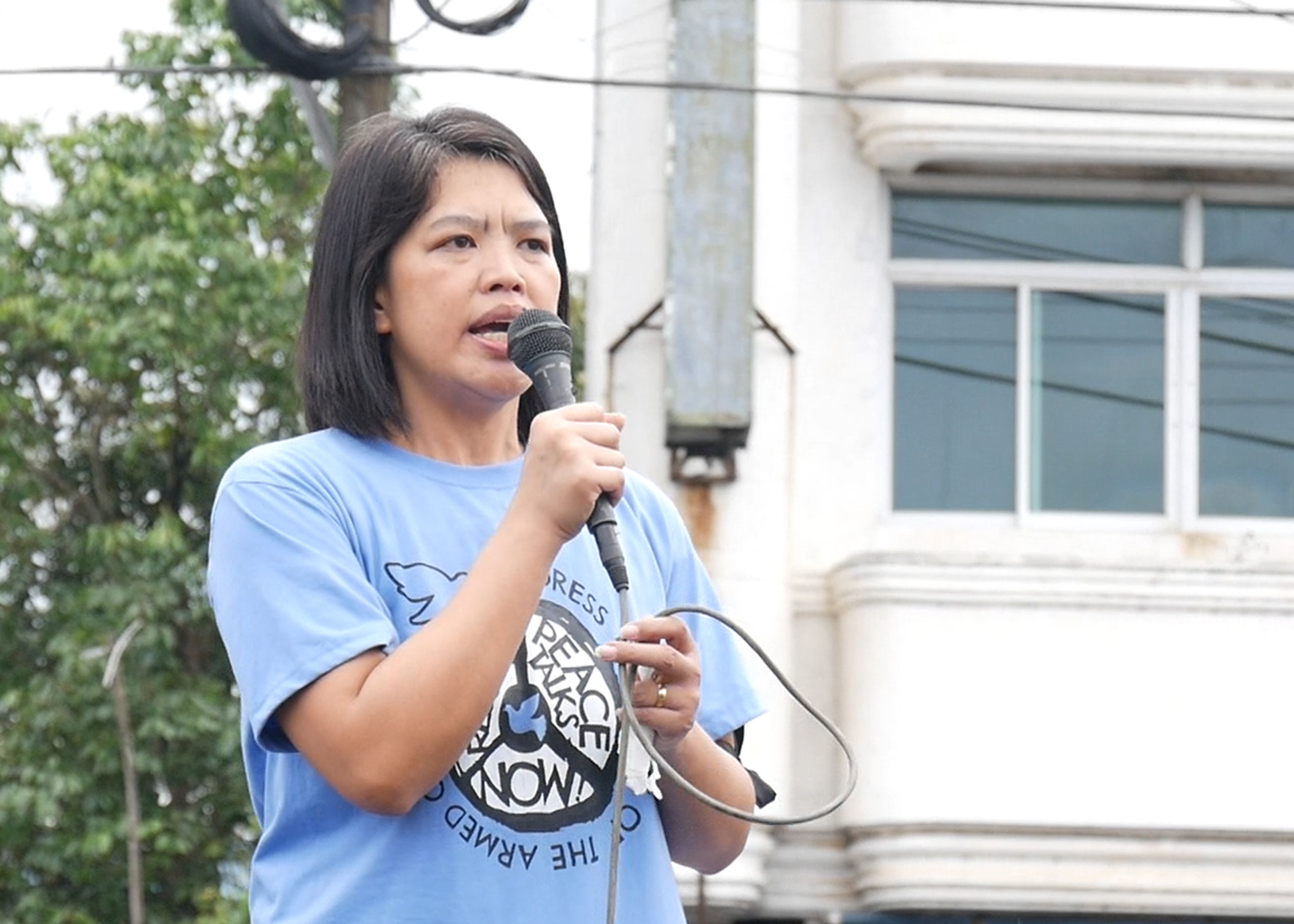
Photo: CWEARC, Inc.
Rachel was falsely accused of murder and attempted murder after a report presented by the 81st Infantry Battalion of the Armed Forces during an alleged encounter between the Armed Forces and the New People’s Army (NPA) in October, 2017. Two months later, Judge Mario Anacleto Báñez, who had ruled in favor of her acquittal, was murdered by unidentified men.
Moreover, Rachel was charged, along with four other women from the Cordillera, with two other counts of murder of the 14 that allegedly occurred in the south area of Ilocos, which is located in the northeast of the island of Luzon, the largest in the Philippines. Rachel and the other four activists were released on bail as the hearings continue during the pandemic.
Time spent in prison: depression, infirmary and organization
Rachel was incarcerated for 11 months and two weeks. The indigenous leader remembers this period with great sadness: “I was separated from my family and the communities that I wanted to serve. I suffered from depression since I could not accept being imprisoned for a crime I had not committed. My family and colleagues’ words of hope gave me the strength I needed to endure the pain while waiting to be released sooner or later. Prison visitations, which were expressions of solidarity and defiance from different communities, sectors and institutions, gave me the courage to continue fighting not only for myself but also for the less fortunate whose rights were being denied”.
In prison, she was considered a “high risk” inmate and, therefore, she was subject to more restrictions. To cope with the situation, Rachel practiced as a health worker: she took the blood pressure of her fellow inmates and advised them of the use of the herbal plants available in prison. Once, the resident doctor called Rachel’s attention and told her to stop acting as a nurse. “Keeping myself busy was my coping mechanism. It was therapeutic and it lifted my spirits”, said Rachel.
Through her work, Rachel gained the respect of her fellow inmates, who valued her commitment towards the right to health: “I started organizing them to reclaim their rights as women, such as being able to exercise using some of the exercise equipment. We were also able to assert that there was no reason for us to do our morning exercise in a place where our bodies were exposed. We were also able to settle petty conflicts among inmates”.
A typical day would include performing the tasks assigned: cleaning, caring for the garden, attending training programs, and assisting the guards in their routine. The seminars included food preservation, bonsai beads craftwork to be sold, organic farming, and first aid training.
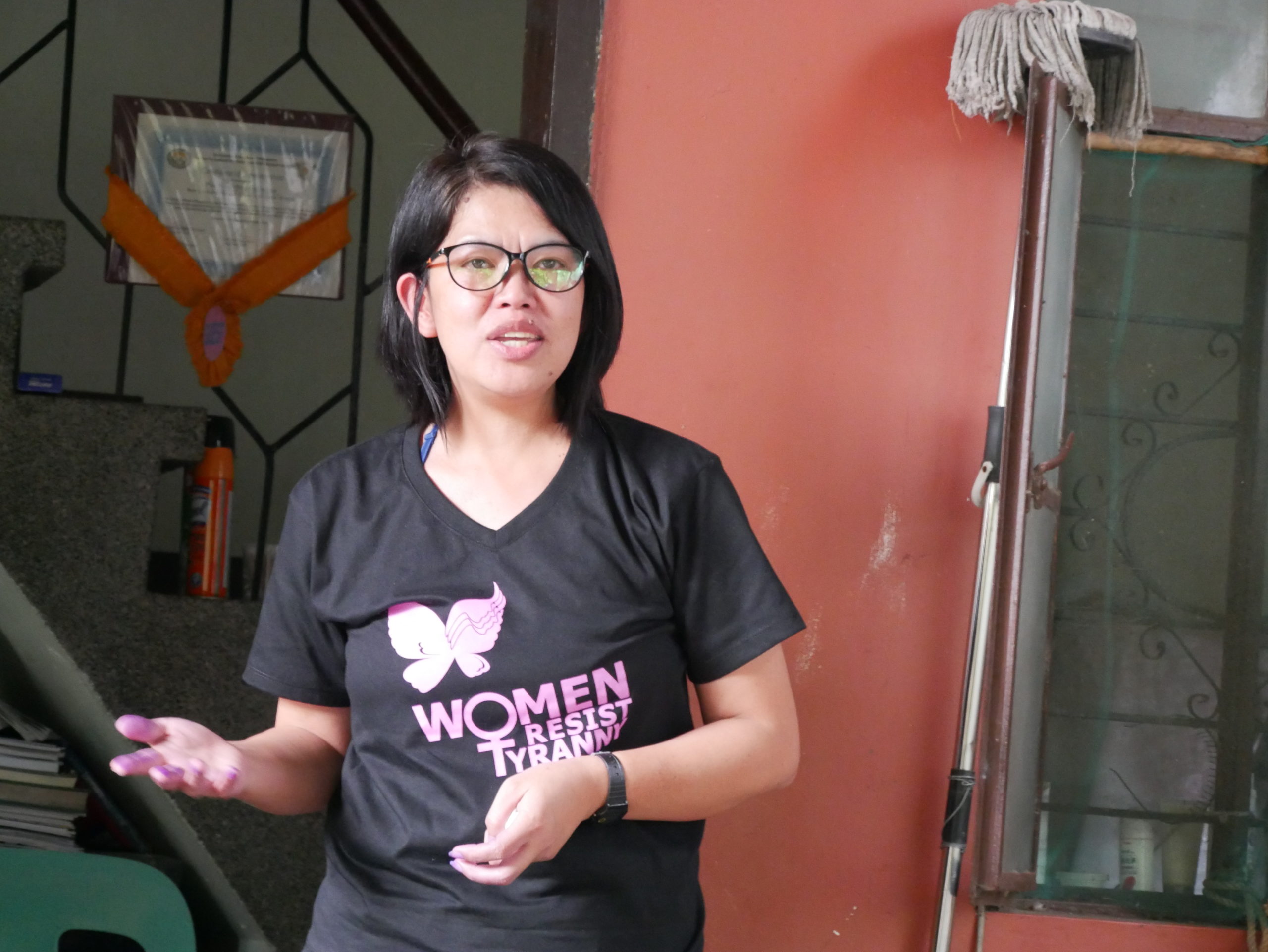
Photo: CWEARC, Inc.
When the light shines the brightest
“My children were the most affected during my time in prison, particularly, my youngest daughter who was about to graduate. Since her father’s salary was not enough to afford the tuition and other school obligations, she was forced to stop studying. My other two children were also scared because of the uncertainty of the unfolding events. The eldest became the spokesperson of the family while my husband had to take care of the daily affairs both in prison and at home. They were very supportive of me”, explains Rachel.
The first thing Rachel wanted to do upon release was to reconnect with her loved ones, her community and colleagues from the Center for Development Programs in the Cordillera to thank them for their support. She also made sure to reach out to people who thought that the false charges were true.
At present, Rachel continues to work as a paralegal with the Cordillera Human Rights Alliance, where she is the spokesperson of Women Resist Tyranny campaign. “I have to continue with what I think now is a moral obligation: to help those who are also accused of trumped-up charges as much as I can. I have been there, and I know how it feels to be imprisoned.”
Last year, in a testimony among advocates of indigenous peoples’ rights, Rachel stressed the importance of defending human rights amidst a crisis: “It is said that we must shine our light the brightest in the darkest of times to forge greater and more meaningful solidarity when repression strikes”.
Betty’s story
Beatrice “Betty” Belen is an indigenous leader from Innabuyog, a grassroots women’s alliance in the Cordillera region. She comes from the Uma tribe of Lubuagan, and, like Rachel, she is a community health worker. Since Betty’s ancestral domain is affected by the geothermal project of Chevron, for a long time, she has been at the forefront of the local opposition to the project together with other women. For this, she has been harassed by the military.
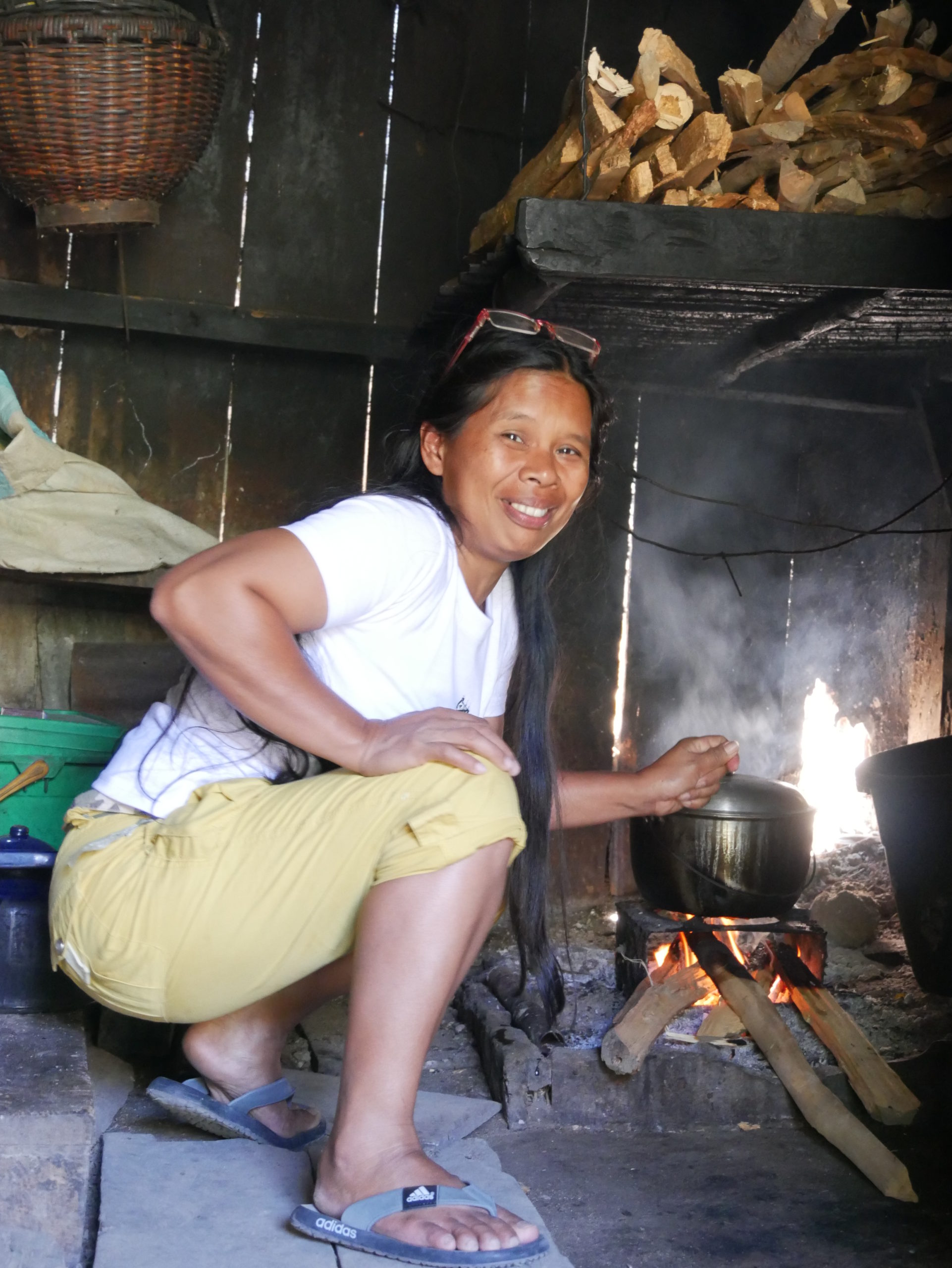
Photo: CWEARC, Inc.
In October 25, 2020, Betty was arrested by a team from the Philippine National Police and the 503rd Brigade of the Armed Forces for alleged possession of three grenades. The evidence was planted. Neither Betty nor her family was inside the house when the search started at 4 o’clock in the morning.
The day she was arrested an indigenous ritual known as pusipos was supposed to take place. The ritual was planned for her father-in-law who was bedridden after being discharged from the hospital. “On October 26, my father-in-law was looking for me. He died on that same day at 8 p.m. My request to see him before his burial was denied. My family waited, but my request was denied,” she recalls. Betty had taken care of her father-in-law for a very long time.
Betty was initially held at the National Police detention facility in Tabuk City, in the same cell as the male detainees. Upon the actions of her lawyer from the National Union of People’s Lawyers, she was transferred to a separate detention space. However, she still had to share the common room and take turns to go to the bathroom. Later, she was transferred to the provincial prison where she was held for three months. Despite the difficulties, Betty encouraged the human rights defenders: “Don’t be discouraged. Grow in strength and number and don’t get tired of our job.”
Betty shared the cell with 13 other women. She was 50 years old, the oldest of the group: “I was quite well-known in prison. I was like an elder sister to them. I explained my work as a woman defender promoting women’s rights and protecting my ancestral lands. That is how they knew why I was in prison”. When the other inmates asked her why she had been charged with trumped-up charges instead of holding those who were liable, the indigenous leader answered that persecution would not silence her because if that happened, more poor people would suffer.
In prison, Betty busied herself with the gardening program. “This was the only time we would feel the fresh air. We grew and harvested a lot of pechay, which we even shared with the other cellmates. The vegetables we cultivated were important because they were the only source of fresh food”.
Their daily ration for the 13 inmates in her cell consisted mainly of 10 pieces of dried fish, two or three pieces of squash, two small tins of sardines, and rice: “The lard and sugar were rationed in the prison commissary”.
The impact of criminalization on family and the community
Due to the pandemic, face to face conversations were not allowed on visitation days. Betty explains the regulations became much stricter: “Only meals prepared by family members were allowed inside. Even if a family member brought you food on a visitation day, you could not talk. We could only wave at each other from afar.” Being away from her grandchildren was among the hardest circumstances she endured while incarcerated. Since the outbreak of COVID-19, Betty had been their teacher, guiding them in accomplishing their distance learning modules.
“It was painful for me to see them without their grandmother. I was very upset. Who would help them with their distance learning modules? They were denied a teacher and a grandmother for the four months I was incarcerated. I later learned that my grandchildren were not able to complete their studies properly. When I was released, someone told me my grandchildren were by the road, waiting for their grandmother to come home”. Once back, the leader said that the kids had lost weight and that they stuck to her all the time. Betty’s arrest also affected the family’s livelihood, which consisted of farming and mushroom production, a common source of income among the Uma tribe. After her arrest, her husband was not able to take care of the mushrooms or tend to the small family farm since he had to take on all the duties in the household.
As a community health worker, Betty raised awareness on proper hygiene, waste disposal, disease prevention; she also accompanied patients to their checkups in the provincial town center, and prepared herbal medicine. When talking to the women in her community, she emphasized the importance of taking care of one’s health and vaccinating children, as well as the need for regular tests and checkups, particularly in the case of the elderly.
“It did not matter that I did not earn any money. What mattered was that I was there to help and guide my community. While I was held, I could not conduct my usual house visitations. So, upon release, I tried to call some of them to ask them about their health. Some of them cried. They told me they felt like orphans”, Betty explains. Apart from spending time with her family, Betty wants to reach out to her kailian (her tribe and community) since she does not want them to be afraid or silenced because of what happened.
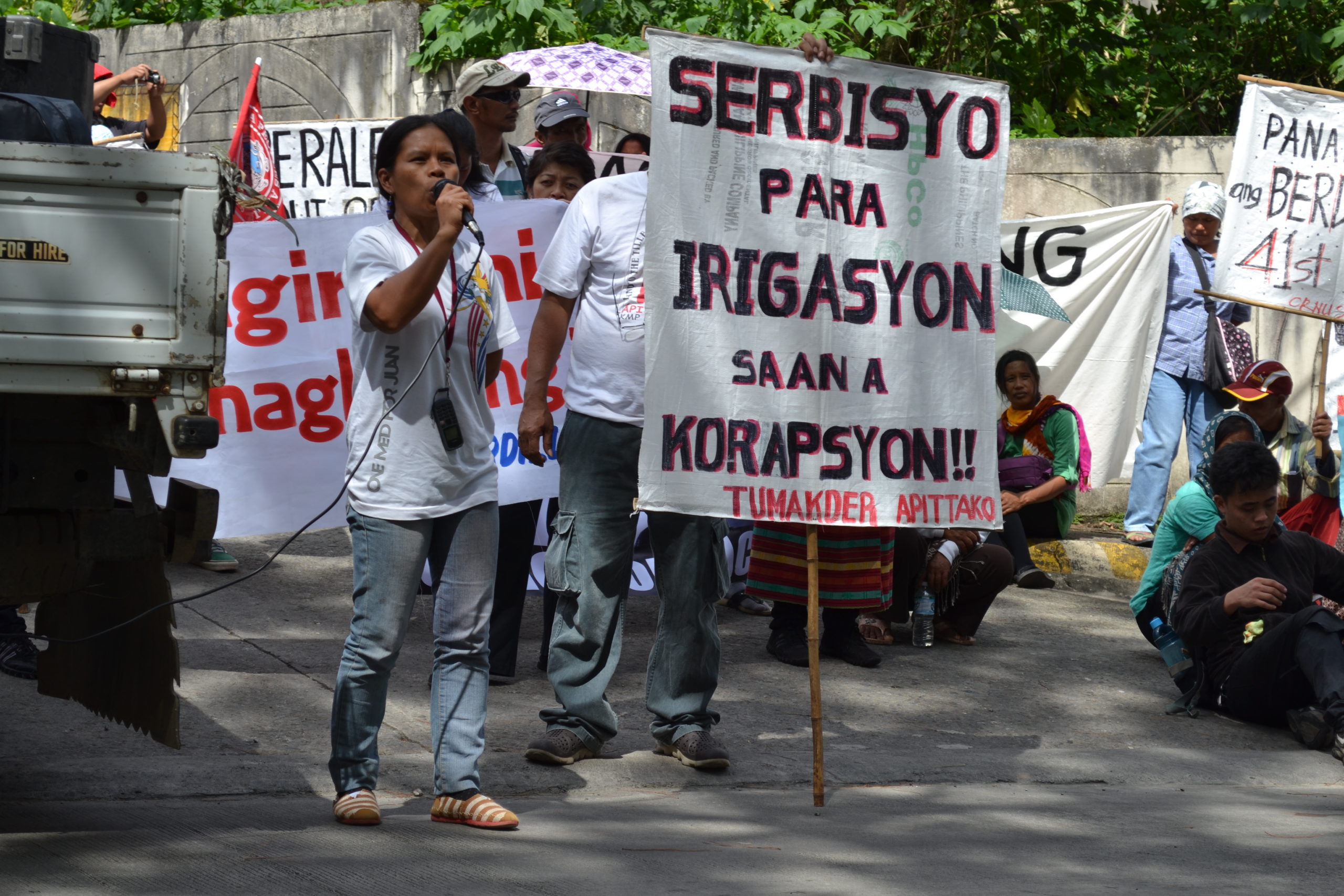
Photo: CWEARC, Inc.
Defenders are under attack
Rachel and Betty are only two of the many women human rights defenders who have been imprisoned in the Philippines. Even though they have been released, the long months of incarceration remain a grave injustice for them, their families and their communities. Their detention denied their families of a wife, a mother, an aunt, a sister and a grandmother. At the same time, their communities were denied of human rights activists who volunteered their skills and time.
The Center for Women’s Resources reported that, until February 2021, at least 20 women human rights defenders had been arrested. Some of them are indigenous women belonging to the Lumad, Aeta, and Tumandok indigenous groups. A report published in Bulatlat.com states that the arrested Tumandok men and women are “staunch defenders of their ancestral lands”. Among the women arrested are Tumandok leaders, Marevic Aguirre and Aileen Catamin. Moreover, the Aeta men and women were all charged with illegal possession of firearms and explosives, but only the men were charged with violating a provision of the Anti-Terrorism Act.
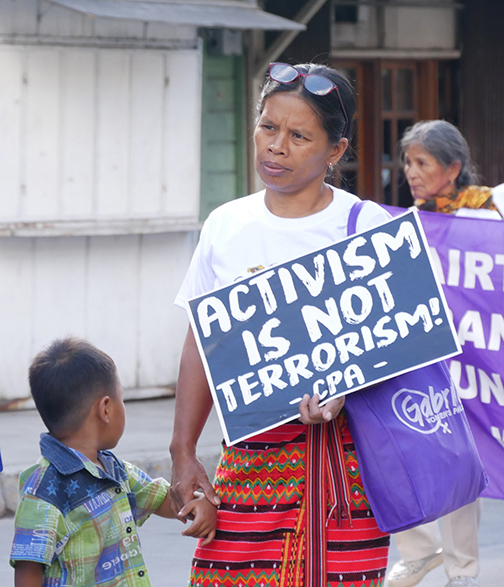
Photo: CWEARC, Inc.
In a public statement titled “Philippines: end attacks against indigenous peoples”, Amnesty International expressed being “deeply alarmed” by the series of escalating attacks against indigenous peoples. It calls on the Philippine government to launch prompt and impartial investigations into these attacks, and prosecute and bring to justice those found responsible in proceedings in line with human rights standards regarding due process: “It should also take concrete steps to ensure the protection, security and well-being of all Indigenous peoples, including those risking their lives to call attention to human rights violations in their communities and fight for Indigenous peoples’ rights.”
This statement also mentioned the case of the Cordillera activist, Windel Bolinget, who faces trumped-up charges of murder. Finally, Amnesty International also emphasized the raid at the University of San Carlos in Cebu leading to the arrest of seven individuals that include two datus – indigenous chieftains among the lumad –, two volunteer teachers and three adult students. They were charged with kidnapping and unlawful detention of lumad children. According to a report by Bulatlat.com, 19 students were taken into custody by police and social welfare custody.
As shown, the Philippine state has decided to move forwards in the persecution of indigenous peoples and defenders of human rights. Women became the target of the criminalization. The international community must be attentive and join forces to protect their rights.#
_____________________________________________________________________________________________
Abigail Bengwayan-Anongos is the Program Coordinator for Indigenous Knowledge Systems and Human Rights Research Support of the Cordillera Women’s Education, Action Research Center (CWEARC).
by Judy Ann F. Basawil | Jan 16, 2021
I started urban gardening many years ago by planting several vegetables, herbs and ornamentals using both practical and traditional knowledge and experimenting. Growing up in the province exposed me to gardening—I do not hesitate to hold and mix the soil for pots and other recyclable materials at home. With a limited space of about 100 square meters, my plants were arranged closely—vegetables and fruit-bearing trees such as lemon, orange, guyabano, coffee, guava and papaya were planted for disaster preparedness and to mitigate landslides during typhoons.
The Ayyew-Ubbo Network which I joined in 2016 contributed solutions to the garbage problem of the city. From 2016 to 2018, the Network conducted community visits, meetings and sharing sessions with urban dwellers in the city. In these activities, planting materials were shared from those who had planted enough for others to bring home and replant in reusable containers. Some survived while others did not, possibly due to soil quality, planting season and maturity of the plant cuttings. A permaculturist friend who volunteered at the Magic Garden of Maryknoll Ecological Garden also shared seedlings which I transplanted at home.
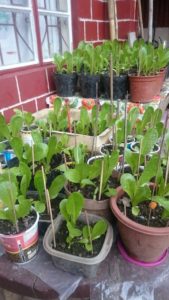
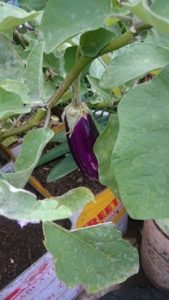
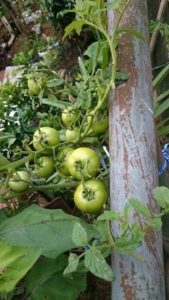
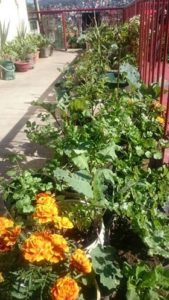
In the last quarter of 2017, I was granted a TESDA scholarship course on Training on Agricultural Crop Production NC2 at The Master’s Garden in Puguis, La Trinidad, Benguet. It was overwhelming, and it enriched by knowledge, skills, attitude and values in organic agriculture.
I continued growing crops in containers at home. The planting material was improved with organic matter, and more kinds of vegetables and herbs were introduced to the soil medium. From here, plants started growing robustly especially during the rainy season. A bin was provided for vermiculture for biodegradable waste consisting of fruit peelings, paper, vegetable trimmings, weeds, dried leaves, chopped banana stalks. These were fed to the vermi worms. The vermi compost and vermi tea were used as fertilizer for the plants. Ducks and chicken were also raised to augment the poultry and meat supply of the family. Vegetable trimmings, sayote, rice, overripe fruits were given to the livestock for food. Their waste was used for fertilizer.
The love for growing plants is indeed a passion and a hobby and it instilled in me the love for learning. It is manageable— just spare time to prepare seed beds for seed germination, composting, plant care and harvest. To sustain it, preserve the soil and continue mixing in compost. In the end, we will benefit from it with crops that are readily available, safe and nutritious especially in times of emergency and crisis. Neighbors, relatives, friends, barangay health workers and officials also appreciated the container gardening we are doing and we look forward for them to replicate this in their homes when they ask for seeds, seedlings and cuttings which we were able to share with them. A minimal surplus of vegetables was sold to neighbors and friends since it was primarily used for food consumption of the family.
In passing, I would like to share this piece which I uncovered:
Voice of Nature
We who live in a city have to make an effort to enter into nature. We must prepare for it and spend time on it.
If we are willing to make a little effort, nature will receive us tenderly and be generously preserved to all naturalists.
***
Editor’s Note: The author is an active practitioner of the Ayyew-Ubbo-Vermiculture (AUV) Model and is an active member of the Ayyew Network. Judy’s work in urban gardening have received recognition—first place in the district level container garden category organized by the City Veterinary and Agriculture Office in 2020.
by CWEARC | Apr 19, 2020
The health crisis and imposition of the enhanced community quarantine (ECQ) due to the Coronavirus disease 2019 (COVID-19) unmasked not only the shortcomings in the Philippines’ health system but also exposed the urgency of addressing issues in food security.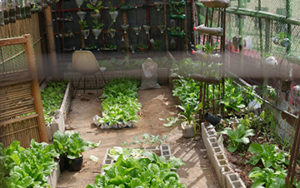
The ECQ’s implementation displaced most low-income families from their livelihood and have no means to buy food, even those who were able to set aside a little and have minimal income face difficulty in procuring food supply. This already difficult plight is worsened by the rising costs of vegetables and other commodities, and the government’s limited and meager economic aid at this time.
As people continue to find ways to keep food on their tables, urban gardening initiatives have started to gain more traction. The national and local government have even started to revive old projects to strengthen individual efforts to grow vegetables in urban areas.
The Department of Agriculture came out with the Ahon Lahat, Pagkaing Sapat (ALPAS COVID-19), or the “Plant, Plant, Plant” program to provide “adequate, accessible and affordable food for every Filipino family.” ALPAS COVID-19 is the centerpiece project of the department “to ensure sustained food production and availability, food accessibility and affordability amidst the threats of COVID-19.” The DA asked for a PhP 31 billion supplemental fund for the project, which includes the revitalization of the urban agriculture and gulayan (vegetable garden) project.
In Baguio City, the City Veterinary and Agriculture Office (CVAO) also distributed vegetable seeds to individuals and barangays. The project, which commenced on March 24, aims to provide a ready supply of vegetables for households and barangays with open spaces or pots in the coming months. The office hopes to strengthen its urban backyard gardening program, which officials tried to institutionalize in 2017.
Meanwhile, in Purok 24 Barangay Irisan, Baguio City, members of Samahan ng Maralitang Kababaihang Nagkakaisa (Samakana) are reaping the benefits of their waste management and food security project that started in 2008.
Lifeline under lockdown
Using recycled plastic containers as pots, Agnes Gampol filled her backyard with vegetables, herbs, medicinal plants, and flowers. At the moment, she has onion leeks, chives, chili, beans, and rosemary, among others. She has roses and alstroemeria. She even planted strawberries.
“The flowers are food for the eyes,” she said.
Agnes knits bonnets for a living. Her husband is a carpenter. The ECQ’s implementation in this pandemic affected their livelihood.
Her family is among the 45,000 low-income households in Baguio City that is now banking on government assistance to get through the pandemic. Without income and with the limited economic relief provided, her urban garden has become one of their lifelines.
She said having a backyard garden helps in ensuring food supply, which became more evident with the current situation.
According to her, the idea of developing a backyard garden came after they attended training on waste management through vermiculture (vermi) in 2013. Vermiculture is the process of decomposting organic materials using earthworms.
“After the training, I just tried vermi worms for fun and to see if it works. I started with four worms, and they multiplied fast, I have been giving away worms since then,” she recalled.
Agnes said her neighborhood was able to reach zero biodegradable waste at one time by raising vermi worms.
“This is still true in my household; my children are now conscious, they segregate the biodegradable,” she said.
Expanding the production
Besides having individual container gardens and backyard plots, members of Samakana also tilled vacant lots to increase their production. In Agnes’ community, she teamed up with some of her neighbors to cultivate an adjacent vacant lot.
Bernardita Espada, 54, is the primary overseer of the collective garden. Agnes and other members of their organization assist her. However, Bernardita, whom they call Manang Bining, takes the lead in maintaining and developing the garden.
“She was already planting some portions of the idle lot, so we asked her if we could join her and develop a wider portion for the neighborhood,” Agnes said.
The owner of the vacant lot allowed them to cultivate while it is idle. They use vermicast and compost to fertilize their crops and sunflower as a natural pesticide. The sunflower also serves as a fence to keep off dogs, cats, and chicken. Sunflower stalks grow into plants just as the vegetable seeds sprout.
Manang Bining explained that she only planted sayote, pineapple, and ginger this first quarter of 2020. According to her, the weather was not suitable for other vegetables.
“It has been frigid and dry since January, and we do not have a water source here in our neighborhood,” she added.
She recalled that in the past years, they were able to grow corn, beans, petchay, and sweet potatoes, among others. They rotate the crops depending on the weather. Around this time of the year, they usually plant petchay and beans. They can harvest the crops by June before the heavy rains come.
“But sayote is all year round because it is the most resilient among vegetables,” she said.
Apart from the seven households that cultivate the plots, the collective garden also provides for other community members. Some of their harvests even reach the public market.
Manang Bining also sells vegetables to her neighbors at a very affordable price. She said there were times that harvest was good; she sold some to the adjacent puroks. According to her, she can harvest as much as 25 bundles of sayote shoots a day during rainy days. The harvest drops to 10 bundles during summer. Her yield is enough to supply some market vendors. A bundle of sayote shoots weighs about a kilo and sells for P20-25 each. According to her, harvest this year is just enough for their consumption. Like Agnes, she said the backyard garden that they collectively till helps ease the limited income and food supply caused by the lockdown.
Harnessing indigenous knowledge
Long-time urban poor leader and Tontongan ti Umili chairperson Geraldine Cacho recalled that the project is among the programs of the Cordillera Women’s Education Action and Research Center (CWEARC). She is one of Agnes’ organic gardening buddies.
Aware of the daily challenge that women in urban poor communities face, the institution partnered with Samakana to address waste management and food security concerns.
The project’s overall purpose was “to enhance indigenous knowledge to support the economic survival of indigenous women in the urban setting.” The proponent integrated the concepts of ayyew (avoiding wastage) and ubbo (cooperation) as indigenous practices with organic farming and protection of the environment.
She said it started as a way to manage biodegradable waste at the household level. When their vermi fertilizer production began to gather momentum, they then started the food security and household nutrition component.
“Vermicast and vermicompost are the by-products of vermiculture; we used these to develop our organic backyard and common gardens,” she said.
According to her, other urban poor women in other areas have developed similar gardens after having vermiculture training. A similar collective garden was set up in Purok 14 also in Irisan; and also in barangays Ambiong, Gibraltar, and San Luis.
Not part of the development plan
Geraldine said that the COVID-19 crisis and ECQ highlighted the importance of urban gardening. She said that the CVAO and the DA initiatives to distribute seeds are welcome. However, she noted that the seed dispersal program in an urban setting could only succeed by assisting existing urban gardeners and intensive education campaigns.
She pointed out that local governments of highly urbanized areas, like Baguio, tend to ignore the significance of growing crops at the household and community level.
“Programs to ensure food security, especially in the urban setting, is often left out when officials plan for development. In Baguio, when we started the program, the city did not give much attention. Officials did not even entertain our call for the bottom-up approach on waste management,” she said.
According to her, the effort of Baguio in 2017 to identify agricultural barangays and promote urban gardening was a positive development. However, “the program focused mainly on promoting urban and organic gardening through competition.”
“Officials who took charge of the program failed to look at it as a strategic economic program for the thousands of low-income families in the city. Also, they did took it as an integral part of achieving zero organic waste,” she added.
Geraldine shared that among the challenges they are facing is water supply – the lack of it during summer and too much during the rainy season. Also, she said the limited space available for planting requires urban gardeners to find other ways to plant their crops, some of which requires added expenses.
“The city must assist us on these matters if it is planning to make its seed dispersal and urban gardening project. They (officials) can do more than just providing seeds like providing training on organic fertilizer. The city can also assist groups to negotiate with owners of idle lands to allow them to cultivate and develop a common garden,” she said.
“We hope that the city will look at the need to develop and assist individuals and groups practicing urban vegetable gardening in the city beyond the COVID-19 crisis,” she added.#
By KIMBERLIE QUITASOL
www.nordis.net
by Jeanree Gabaen | Feb 8, 2020
“Annie” is a twenty-year-old Kankana-ey born and raised in Mankayan, Benguet. She comes from a family of seven, wherein she has her parents and her four younger siblings. Her parents are trying their best to make do with the meager wages that they earn from informal jobs. Despite their efforts, the pay they receive is not enough for their growing family.
She migrated to Baguio and took a Bachelor’s Degree in Education at a university, hopeful of finding a job after her study.
In her second year, Annie decided to forgo her studies and work as a call center agent. Her desire to help her family cope up with their ever-increasing financial needs forced her to make the decision. Also, her mother’s sacrifice, who is currently working as a domestic helper in Hong Kong, inspired her to act.
Annie’s mother went there before but had to come back home due to the abusive labor practices of her former employer. The increasing prices of essential commodities and lack of job opportunities here in our country led her to leave her family again.
Meanwhile, Annie’s younger sister, who should be in junior high school, also had to set aside her studies to help her older sister and mother. The three of them are doing their best for the survival of their family.
Annie may not have been able to finish her college degree, but she hopes and prays that her younger siblings will be able to finish theirs. She would sacrifice her studies for the sake of her younger siblings.
Annie’s story and that of millions of Filipinos in the margins of society is a reflection of the current economic crisis in the country. Family members, especially the women and older siblings, are forced to sacrifice their personal dreams to help their family survive. They have to make hard decisions to cope up with the rising prices of basic goods and lack of job opportunities.
This situation is a result of an unjust system. The vast resources of our nation are concentrated among a few individuals. Meanwhile, the more significant part of the population struggle to have a piece from the meager portion left to them.
It has become routine for older children to let go of their studies and for parents to leave their families to look for “greener” pastures. However, this should not be. This is why we need to change the way our country’s resources are allocated by involving ourselves in the creation of just laws. Education, healthcare, and local job opportunities must top the list of the national budget. The government should also craft laws that are not oppressive and abusive.
This is one of the many advocacies of the Cordillera Women’s Education Action Research Center (CWEARC) and Innabuyog in the Cordillera. Women, from the different sectors of the society, must work together to remind the government that it was created to serve the people. This state mandate is clearly stated in the Philippine Constitution. Officials should cease from becoming puppets of the rich and the powerful. The government should not oppress the already marginalized sectors of society, which includes the laborers, landless farmers and the indigenous peoples.
However, when people’s organizations, where women are a part of, come together and try to help people like Annie, they are tagged as enemies of the State. Instead of working together with these groups, the State uses its power to suppress these organizations. These are proof that the government works for the wealthy. It is not a government for and by the Filipino people.
Let us make Annie’s story an inspiration to be more active in the social and political affairs of our country. Her story is one of the many problems that Filipinos have been facing. If we continue to be blind to these, these issues will persist and escalate. It must be during these times that we work hand in hand to bring about change. Children must finish their studies for it is their right and, parents should not be forced to leave their children just to make ends meet!
by Wesley Balaguio | Dec 15, 2019
If you are like the vast majority, you probably haven’t heard of the ‘ball-squeezing’ and ‘breast-baring’ women who defended our ancestral lands from threats of unmerciful destruction. For that, you are not to blame because believe it or not, we have a state that is trying to revise our history of resistance.
When remnants of our colonial past became a tool for those who have grown to feed off the capitalist world system, our ancestral lands became sources of profit for the few. Giant corporations partnered with the state to legitimize their plans for “development” in our ancestral lands – thus the birth of ‘development aggression’ or the imposition of destructive projects in our territories.
Article III of the United Nations Declaration on the Rights of Indigenous Peoples, which the Philippines is a signatory of, states that indigenous peoples have the right to self-determination – a right to freely pursue their economic, social and cultural development. However, in the experience of indigenous peoples around the world, development meant displacement from their ancestral lands, cultural bastardization, and human rights violations.
This is not far from our experience here in the Cordillera region.
When the Marcos regime implemented its deceptive economic agenda in the ’70s through the 80s, the Cordillera region became a target for exploitation. Thus, the government opened the region to numerous “development” projects that would have displaced us, indigenous peoples, from our lands.
In Mainit, Bontoc, Mountain Province, the Benguet Corporation Inc., a large-scale mining company was set to displace the indigenous communities in the area and wipe-out their source of water and livelihood – the mountains and the rice terraces. Enraged, the Mainit women led by Mother Petra Macliing organized themselves for a common cause – to stop the mining projects from encroaching in our mountains. Together they linked arms and ‘squeezed the balls’ of the mining engineers as an act of protest. When things started to escalate, the women disrobed and bared their breasts, daring the engineers to harm “the womb from where they came from.” After driving them away, the women raided the miners’ camp. They then returned the mining equipment to the company’s main office at the town center.
In Kalinga, the World Bank-funded Chico River Basin Development Project sought to build a series of dams along the Chico River, threatening to submerge our homes and sacred burial grounds. In response, the indigenous women, together with other sectors, made their opposition known. They led various protest actions to stop the project and were met with military suppression, which also resulted in the murder of Kalinga pangat, Macliing Dulag. Despite death threats and political repression, we defended our waters.
Moreover, in Abra, a 200,000-hectare logging and paper-pulp concession were awarded to the Cellophil Resources Corporation (CRC). The owner, Herminio Disini, was a Marcos crony infamous for his involvement in the corruption-ridden Bataan Nuclear Power Plant deal. The logging operations of CRC evicted indigenous farmers in lowland Abra from their rice fields and homes. It would have resulted in the total denudation of the forests in the province and the drying up of headwaters of major river systems in the Cordillera and Ilocos.
Aware of the destruction the project will bring, people from all walks of life all over Abra unite to demand that CRC respect their rights to their ancestral lands and resources. Not long after, CRC was forced to shut down because of sustained opposition from the Tinguians.
Today, the same threats are looming over our mountains when we see a repeat of these experiences. President Rodrigo Duterte’s economic policy, ‘Build, Build, Build,’ opened the Chico River once again to a multi-billion irrigation project funded by Chinese investors. Moreover, Nickel Asia, a multinational corporation, and its local subsidiary, Cordillera Exploration Company Inc. (CEXCI), have a mining application covering 15 municipalities in the region. Various large and mini-hydro projects are also forced upon our communities.
All these ‘development’ projects were made possible through manipulated, or fraudulent free, prior, and informed consent (FPIC) processes, clearly disregarding our right to self-determination. And despite disinformation about development aggression, our people are not letting their guards down.
Progressive and grass-roots based organizations in the region are already up and standing against development aggression. However, the opposition is not sitting well with the state that has unleashed intensified attacks against our women’s land defenders.
Many of our mothers and sisters now face harassment, political persecution, and other forms of human rights violations. What is more alarming is the vulnerability of women in rural communities to state-perpetrated violence where state forces are deployed and encamped.
There are endless issues faced by our women in the region, many of which we do not personally experience. But do we have to become the victims to realize how grave the situation is? We should not let the state subject us to their economic policies designed to disconnect us from our land. Our assimilation into a colonial culture that would bastardize our identity in the name of ‘development’ should not be allowed.
It is noticeable that we have a growing engagement of the youth in today’s climate crisis. However, issues of climate change in the country seemed to be understood in a superficial context. We must widen our perspective concerning environmental issues and connect them with land issues faced by our people.
As young indigenous women, we should be the reflection of Mother Petra Macliing, of the Bontoc women; and of the Kalinga women today. We must resist collectively to prevent the destruction of our only home and heritage.
In an authoritarian regime where systemic violation of our land rights and women’s rights are worsening, there is a grave need for us to learn from our history of resistance. When it comes to issues affecting our ancestral lands, it must be us, the indigenous youth, who should hold an unyielding desire to defend it. Let us become the real activists and agents of genuine change our peoples and country need.
by Cynthia Dacanay-Jaramillo | Oct 14, 2018
October has been declared as World Mental Health Awareness Month by the World Health Organization (WHO). Awareness is really a key element in addressing this societal concern most especially that Mental Health is rarely discussed and studied and there is still considerable stigma and taboos on matters surrounding mental illnesses.
Reports indicate that 17 to 20 percent of Filipino adults experience mental health disorders, while 10 to 15 percent of Filipino children, within the age group of 5 to 15 suffer the same. NSO accounts mental health illnesses as the third most common forms of morbidity for Filipinos.
According Philippine Health Information System on Mental Health (PHIS-MH), schizophrenia is the top mental health problem in the Philippines, affecting 42 percent (mostly males) of the group studied. Also included in their list of disorders common to Filipinos are depression, anxiety disorder, schizoaffective disorder, acute and transient disorder, and stimulant-related issues.
In the Philippines, various stakeholders have already started to aggressively raise awareness of the public regarding the issue which is a most welcome development. However for most of these interest groups, mental health awareness usually merely focus on identification of certain MH disorders, on signs and symptoms on what to watch out for and the management or treatment of such illnesses. What are left out are similarly important issues that impact on the mental state of individuals but are relegated to the side lights or oftentimes even completely disregarded. These are the social determinants to mental health.
A sound socio-economic milieu is vital to maintaining a sound mental health. In a society where social inequity is widespread, we also find particular sectors at high risk of suffering from physical and mental health challenges.
The WHO captures the crux on the social determinants of the mental health. It aptly stated that “Certain population subgroups are at higher risk of mental disorders because of greater exposure and vulnerability to unfavourable social, economic, and environmental circumstances, interrelated with gender”.
There is recognition that gender is also of vital concern in mental health because of women’s marginalized status in society. But considering that majority of women belong to the lower class levels in the social ladder make them even more vulnerable in acquiring MH disorders.
In our society where almost 18 million Filipino families are already destitute, surviving on incomes below the family living wage of Php30,000 per month (IBON Research group) , where unemployment and underemployment rates are high (there is a considerable 11.5 million who are without work or still looking for more work because of the poor quality of jobs) where inflation rate has been fast increasing, and now at its highest at 6.7 while majority of workers live on pitiful wages, we can surely find majority of Filipinos trying to maintain their mental well-being a major challenge having to face issues of their family’s survival.
We have heard about the case of Kristel Tejada who took her life by consuming a silver-cleaning fluid in March 2013 . She was unable to pay her tuition at UP Manila of Php10,000 because of the “no late payment” policy of the state university. The family had faced financial difficulties after her father was laid off from work at a factory that closed down early on. A few years prior to the Tejada case, Mariannet Amper, a 12 year old girl from Davao also committed suicide out of despair for her family’s impoverished life. In the Philippines, WHO estimated the number of suicides in 2012 at 2,558 mostly among the youth (550 female, 2009 male).
We can also surely find other distressed sectors among the urban and rural poor, where they constantly face the threats of demolition or of being driven out of their lands because corporations are converting them into subdivisions or commercial estates. Or of indigenous peoples, whose territories are being militarized because mining companies’ interest are being protected by investment security forces designated by the government wanting to exploit the rich mineral resources of their communities. In militarized communities, children expressed not being able to sleep well and of experiencing nightmares and bed-wetting, which are apparent signs of trauma.
Then there are those being pursued by the state and it’s security forces because of their political beliefs and for asserting their rights. For those suffering from political persecution and vilification, and where threats to one’s life are constant realities, stress and trauma are too common. Such are the cases of the 5 women human rights defenders belonging to cause-oriented NGO’s from the Cordillera facing trumped up charges or those in the terrorist proscription list. One of them, Rachel Mariano is now languishing in jail for a crime she was falsely accused of. This matter triggered her Hyperthyroidism aggravating the trauma she suffers on the ordeal she had to face together with her family. Depression, sleep problems, fast heartbeat, heat intolerance, weight loss and crying spells are just some of the symptoms she endures.
Additionally, poor women’s burdens are made worse because of their subordinate status in society. Societal norms and standards make them vulnerable to abuse. Women have to contend with society’s expectations on how women should behave and act in ways that are “proper”. Otherwise, society dictates that they deserve the violence inflicted on them. Violence against women is common in our society where sexualisation and commodification of women’s bodies are widely accepted but ironically puts women in a much disadvantaged position. There are also certain mental health disorders that are more common to women such as anorexia nervosa or bulimia. Women’s distorted ideas about their bodies are due to social beliefs on images and roles demanded of women in society. Women’s standards of beauty are that of models and beauty queens who must be fair, tall, thin and who must have bodies with “perfect” vital statistics. It is then no wonder why many women are conflicted contributing to their low self-image and worth.
All of the above social determinants of mental health are factors that make one more at risk to mental health disorders. The higher the social inequities, the higher vulnerability particular groups in society face.
Addressing our mental health concerns therefore entails not only tackling the issues of individuals facing mental health issues. It must in fact address the root causes of social inequalities that make marginalized segments in our society more vulnerable in suffering mental health disorders. A comprehensive program in tackling the issue is therefore of paramount importance. It cannot be denied that the prevalence of mental Illness in our country is a mere reflection of the social ills plaguing our society.










